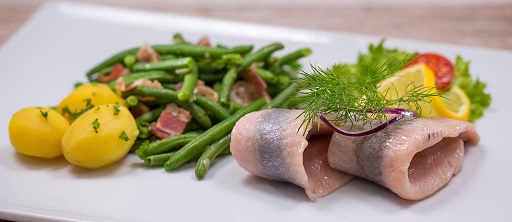
When people think of German cuisine, images of bratwurst, schnitzel, and pretzels often come to mind – all staples of southern Germany. But head north, and you’ll discover a culinary world shaped not by alpine traditions, but by coastlines, rivers, and seafaring history. Northern German cuisine is salty, hearty, and shaped by centuries of maritime life. It’s a region where pickled fish, dark rye bread, and robust kale stews take center stage.
In this article, we dive deep into the flavors, traditions, and stories behind the dishes of Northern Germany. From the harbors of Hamburg to the wind-swept plains of East Frisia, discover how geography, climate, and culture have crafted a unique regional cuisine that’s as satisfying as it is soulful.
➡️ Related: Traditional German Food: A Culinary Tour Through the Regions
What Defines Northern German Cuisine?
Northern Germany stretches from the North Sea to the Baltic and includes states such as Schleswig-Holstein, Lower Saxony, Hamburg, Bremen, and Mecklenburg-Vorpommern. This region is marked by:
- Access to abundant seafood
- A strong history of preservation (pickling, curing, smoking)
- Long, cold winters that demand hearty, warming food
- Protestant traditions that emphasized simplicity and frugality
Here, meals are practical but never bland. The north embraces sour, salty, and smoky profiles – flavors designed to withstand time and tide.
Key Ingredients and Flavor Profiles
- Herring and other oily fish (fresh, pickled, smoked)
- Grünkohl (curly kale)
- Pinkel (a smoked sausage with oats)
- Potatoes (in every imaginable form)
- Rye bread (especially Pumpernickel and Schwarzbrot)
- Caraway, dill, juniper (for seasoning and curing)
- Apples and cabbage (used in salads, sides, and slaws)
Northern German food rarely uses cream or heavy sauces. Instead, tangy vinegars, briny flavors, and hearty fats dominate the landscape.
Famous Dishes from Northern Germany
Let’s take a closer look at some of the region’s most beloved foods:
1. Matjeshering (Young Pickled Herring): A true North German classic. Matjes are young herring cured in a mild brine and often served with apples, onions, sour cream, and potatoes. The combination of sweet, sour, and creamy defines this dish.
2. Labskaus: A sailor’s dish turned delicacy. This mashed mixture of corned beef, potatoes, onions, and beetroot is served with rollmops (pickled herring), gherkins, and a fried egg. It may look unusual but packs incredible flavor and history.
3. Grünkohl mit Pinkel: Kale cooked slowly with onions, bacon, and sausages like Pinkel and Kochwurst. Traditionally eaten after a winter walk with schnapps, this dish is the star of North German winter.
4. Fischbrötchen (Fish Sandwich): A quick street-food-style sandwich with pickled herring, smoked mackerel, or fried fish, served on a crusty roll with onions and remoulade. Found at every harbor and train station from Hamburg to Kiel.
5. Rote Grütze: A red berry compote made with currants, raspberries, and cherries, thickened with starch and served with vanilla sauce or cream. A classic North German dessert, light but flavorful.
➡️ Related: German Bread Culture: Why It’s UNESCO-Recognized
Bread and Baking Traditions
Northern Germany is a paradise for bread lovers – especially those who appreciate dense, flavorful loaves:
- Pumpernickel: A dark, sweet rye bread baked for up to 24 hours.
- Schwarzbrot: Coarse rye bread, usually sliced thin and spread with butter, cheese, or fish.
- Friesisches Schwarzbrot: Hearty, moist rye bread from East Frisia, often paired with smoked fish.
Bread is not just a side here – it’s an essential part of the meal, often the base for Abendbrot (evening meal).
Eating Habits and Mealtimes
Northern German meal customs follow the classic German rhythm:
- Frühstück (Breakfast): Bread with cold cuts or jam, hard-boiled eggs, and coffee
- Mittagessen (Lunch): The main meal – fish, meat, or stews with potatoes
- Abendbrot (Dinner): Bread, cheese, pickled vegetables, and cured fish or meats
In cities like Hamburg or Bremen, lunchtime might include Labskaus or a Fischbrötchen, while rural communities might gather for a seasonal Grünkohlessen (kale feast).
Grünkohltouren: A Winter Tradition
One of the most charming customs in the north is the Grünkohltour – a winter walk with friends that ends in a hearty kale dinner and beer or schnapps. Often accompanied by games and singing, it’s a true celebration of community and cuisine.
The Role of the Sea
Northern German cuisine wouldn’t exist without the sea. The influence of maritime trade, fishing, and naval life is everywhere:
- Dried and salted fish sustained sailors for centuries
- Herring festivals mark the start of fishing seasons
- Coastal towns boast seafood markets and open-air eateries
Smoked Fish Specialties:
- Räucheraal (smoked eel): Rich, fatty, and traditionally served cold
- Makrele (smoked mackerel): Often served whole with horseradish
- Lachsforelle (smoked trout): Popular in inland northern rivers
Festivals and Food Events
Northern Germany hosts a variety of food-centric events:
- Kieler Woche: Sailboat regatta meets seafood extravaganza
- Grünkohl Festival in Oldenburg: A kale-lover’s paradise
- Fish Market in Hamburg: Weekly event featuring fresh fish, bread, and performances
These events preserve culinary traditions and showcase local producers.
➡️ Related: Seasonal German Foods: From Asparagus to Christmas Goose
Modern Influences and Evolution
While rooted in tradition, Northern German cuisine has evolved:
- New Nordic cuisine has inspired lighter, foraged dishes
- Immigrant communities (especially from Turkey and Poland) have introduced new flavors
- Sustainability has brought a focus on regional fish and organic farms
Still, the staples remain beloved. Labskaus and Grünkohl aren’t going anywhere.
Northern German food might not be as flashy as its southern counterpart, but it offers a soulful, deeply satisfying experience. It’s food born of the sea, of long winters, of simplicity and strength. Whether you’re biting into a Fischbrötchen by the docks or gathering around a Grünkohl feast in January, you’re participating in a living culinary heritage.
➡️ Explore the full series:
